Several weeks ago, I made a trip to Smith Teamaker’s to try out some new tea concoctions they were working on. Tony Tellin, the lead blender was already doing a pouring of their new Masala Chai ON NITRO! . . . and I stuck around to try something else that was not yet on the market. He and a few other staff members had informed me that they partnered with Tyler Malek – owner of Salt & Straw, a local ice creamery – to create a new oolong blend.
This was fascinating to me on two levels. One, when I thought of Salt & Straw, I didn’t think of “tea”. All I thought of were long lines.
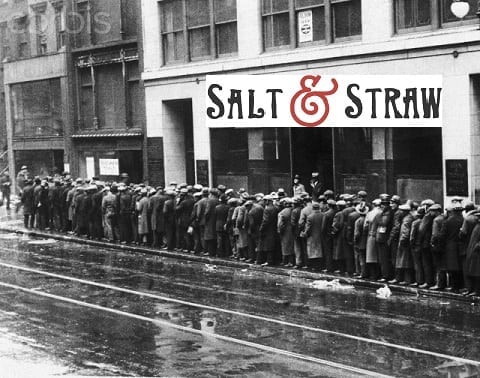
Really long lines. The place was almost too popular a spot in Portland.
That said, somehow/someway both Tony ‘n Tyler got together and concocted this . . .
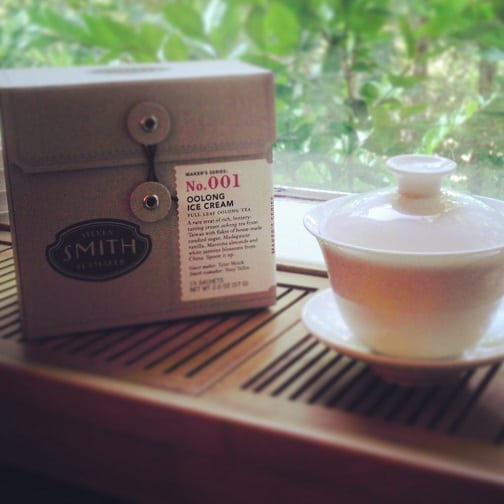
. . . and dubbed it – fittingly enough – Oolong Ice Cream. The first in a limited edition line of teas called The Maker’s Series.
I asked Tony how the blend was made, and the explanation just about made my eyes glaze over. He, literally, had to explain it to me twice and send me an e-mail so I could get the process all down.
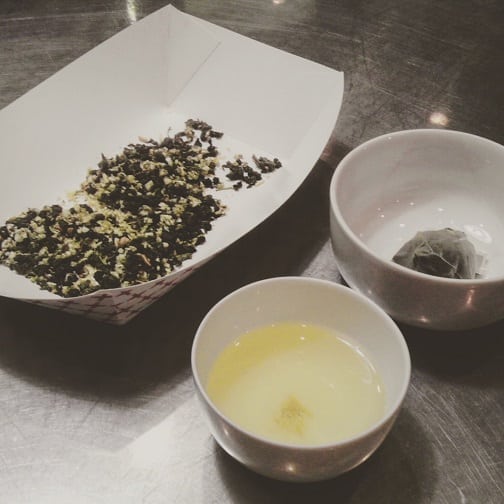
First, they sourced a Jin Xuan milk oolong from Nantou county, Taiwan. Milk oolongs from that region were rather dicey. While “officially” they were supposed to have a naturally milky/silky taste due to temperature changes during the harvest period, the Taiwanese had been known to milk-steam the leaves prior to drying/rolling. It was a minor cheat, but a cheat nonetheless. However, Tony assured me this stuff was the real deal.
Next, they dry-scented the oolong leaves with bourbon vanilla bean for one month. After that, Marcona almonds were cut and sifted, then the dust from the cuttings were reserved for later. White jasmine blossoms were conditioned and sifted. Indian sarsaparilla root was also sifted.
Last but not least was Tyler Malek’s addition – making sugar candy. Cane sugar was melted and poured over bourbon vanilla dust from the original sifting. Sea salt was added, then the concoction was left to stand and solidify. The candy was, then, cracked and sifted to about the size of ball-fisted oolong leaves, and – finally – blended with the almond dust from way at the beginning.
In short, a lot of work went into this. A less ambitious blender would’ve just added ice cream flavoring and called it a day. The result was a beautiful blend that looked (and smelled) similar to ice cream – as was intended. Before I left, Tony gifted me with a few sachets to play with.
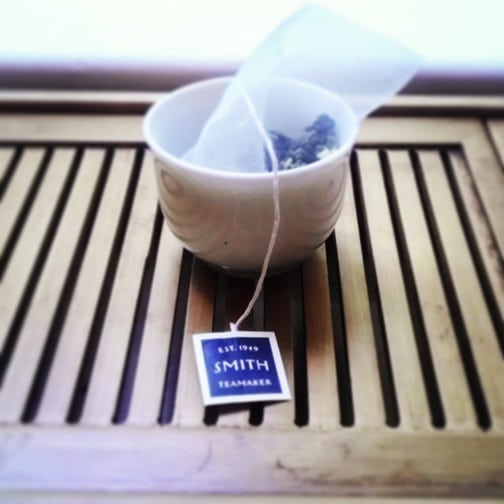
From within the sachet, the leaves looked predominately . . . well . . . oolong. The jasmine blossoms rounded out the palette with their yellowness. But for the most part, this was all oolong. All ball-fisted green meteorites of glory. It was difficult to see that anything had been done to them at all, save for the addition of flowers. The aroma gave a different impression. No joke, it smelled like a root beer float laden with buttermilk ice cream.
For the first test, I brewed this Western-style(ish) in the sachet . . . with the gaiwan. I used boiled water (cooled for three minutes), then steeped it for three minutes.
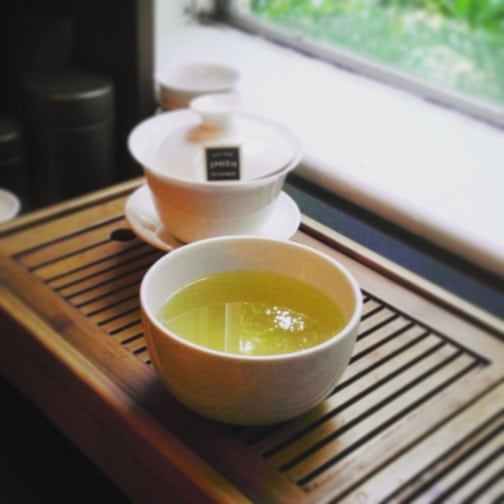
The result was a pale yellow liquor with an aroma of sweetened butter and vanilla. On taste, there was a crisp vanilla smack on the tongue, followed by a popcorny massage in the middle, which then curtsied with a sweet-flower outro. I seriously wanted this as an actual ice cream. Or rather, probably not. I would down this by the pint – nightly.
Next up, I de-sachet the leafy bits and decided to gongfu ‘em. I was interested to see if three short infusions yielded different results given the elements at play.
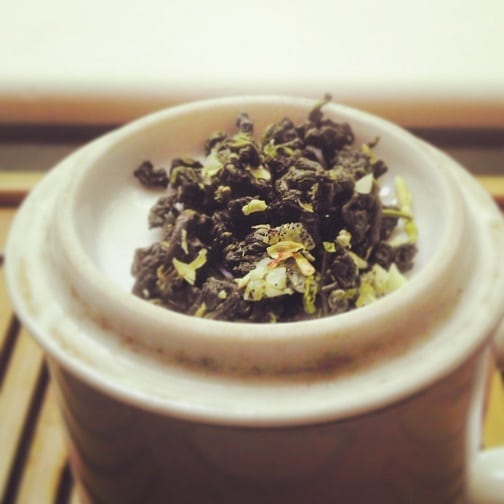
After cutting open the sachet, I got a better look at the leaves and other components. The flakes of almonds and vanilla beans were more clear to the eye, now. And the aroma seemed somehow . . . freed. More floral, but also more creamy.
First infusion (thirty seconds): More aromatic and floral on the front, followed – very distantly – by the vanilla cream sweetness that was added. Like a regular Ali Shan that’d been dipped in honey.
Second infusion (thirty seconds): More crisp than the first infusion, but also sweeter. The vanilla-nut dual punch comes through far stronger than the milky Jin Xuan oolong, which takes an only partial backseat (but still gives directions).
Third infusion (forty-five seconds): Oh wow, creamiest of the three! All the butternut-vanilla-ness came out in one wallop on first sip. Not as strongly floral as brewed Western-style, but retaining all the bits that gave it that ice creamy moniker.
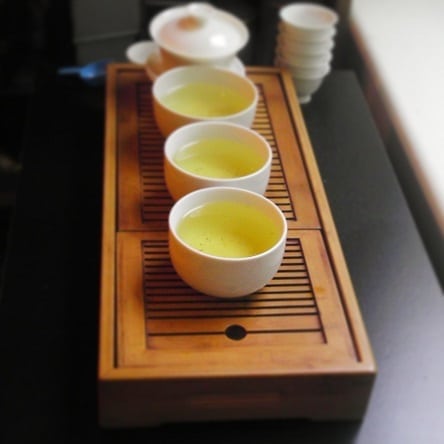
But I wasn’t done, yet. I still had four more sachets, and a thought kept nagging me: What would this taste like as a latte? Around the same time, someone on Instagram mused about what it would taste like iced. That got me wondering as well. And, so, I made a trip down to Smith HQ to find out. Luckily, I was able to convince the staff to humor the odd request for both preparations.
First up, the latte.
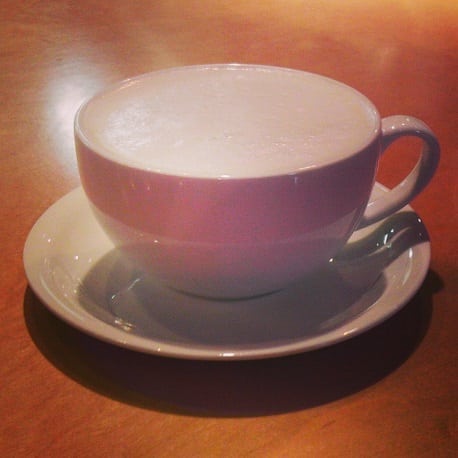
Two sachets were used along with 1 tsp. of sugar, half-‘n-half and 2% milk. The result was . . . well . . . perfection! This tasted exactly like melted ice cream. And I was all-too-familiar with that taste, having left many a bowl of ice cream unattended after scooping. The creaminess was more pronounced in this form.
And lastly, the iced tea.
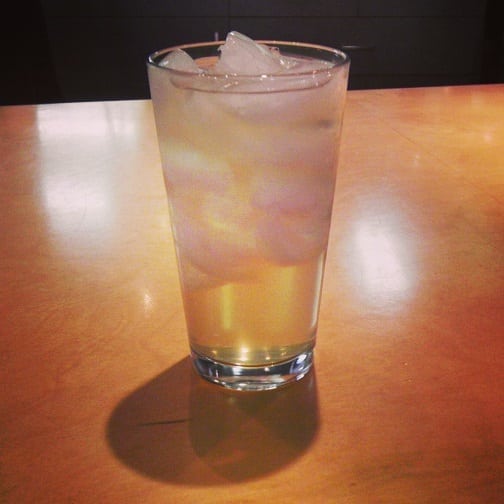
Simple prep: Pint glass, two sachets brewed as a concentrate, poured over ice. Done. This was perhaps the weakest form. None of the vanilla, almonds, or sweet aspects showed through as prominently. The dominant notes were – oddly enough – the oolong aromatics and the floral jasmine. Those took point with some residual sweetness on the back-end.
It took me about a month to get to this writing. The limited edition boxes they prepped for this blend sold out within two weeks after pressing. That revelation almost made me regret going through so many sachets, brewing this up every which way. But only “almost”.
Yeah, I’d stand in line for this.
Leave a Reply